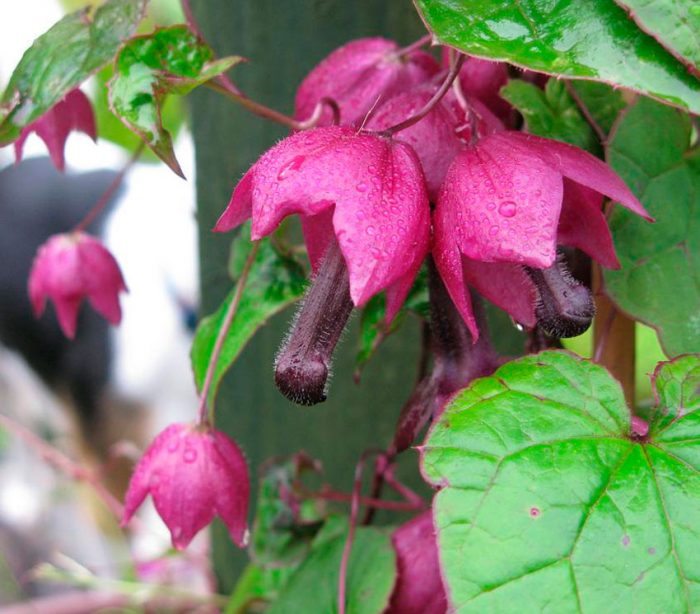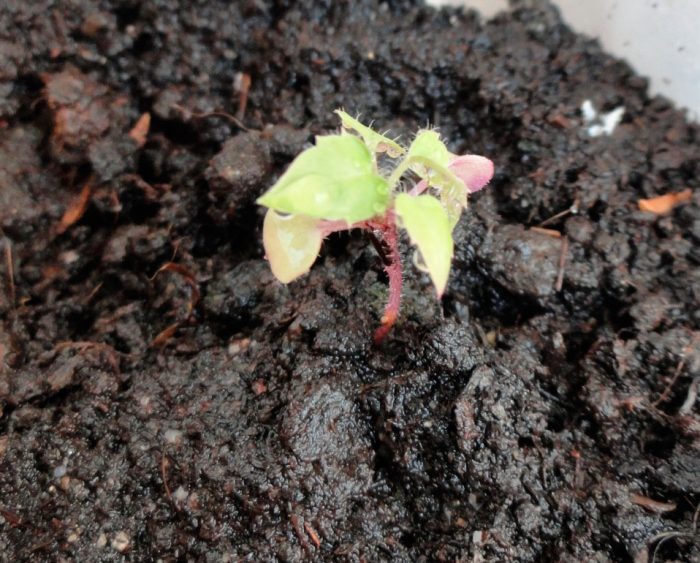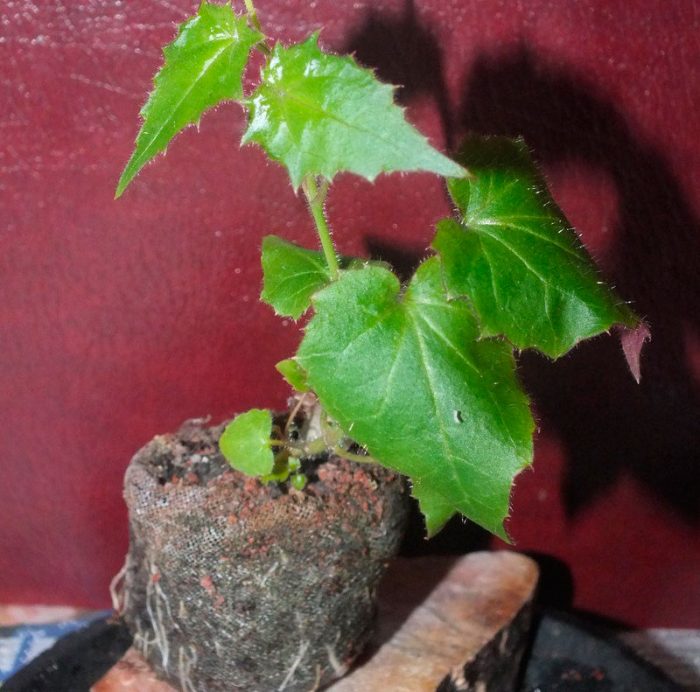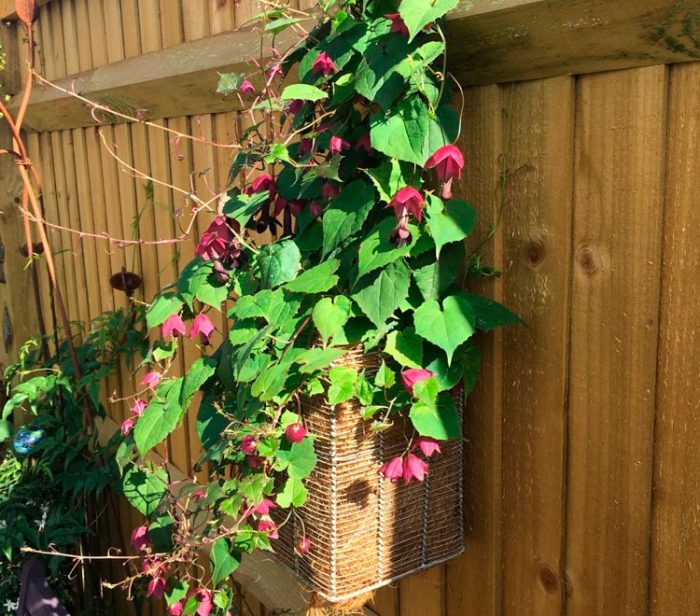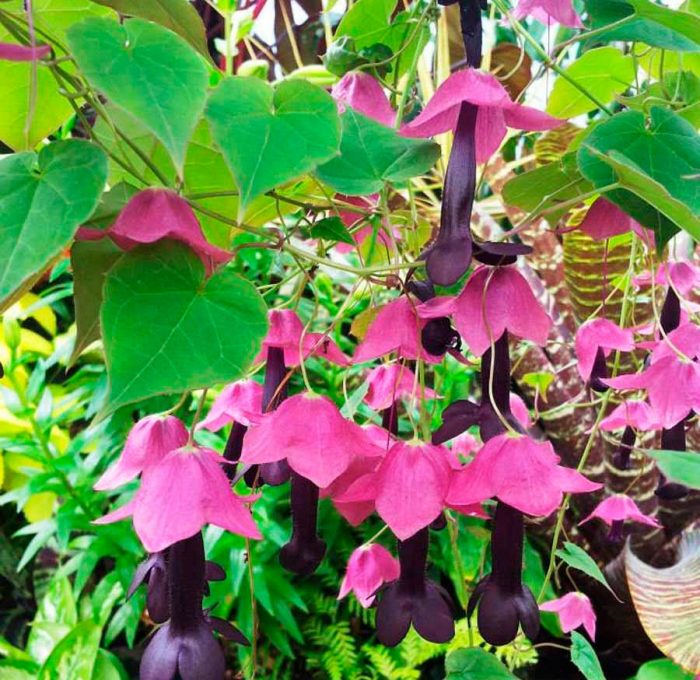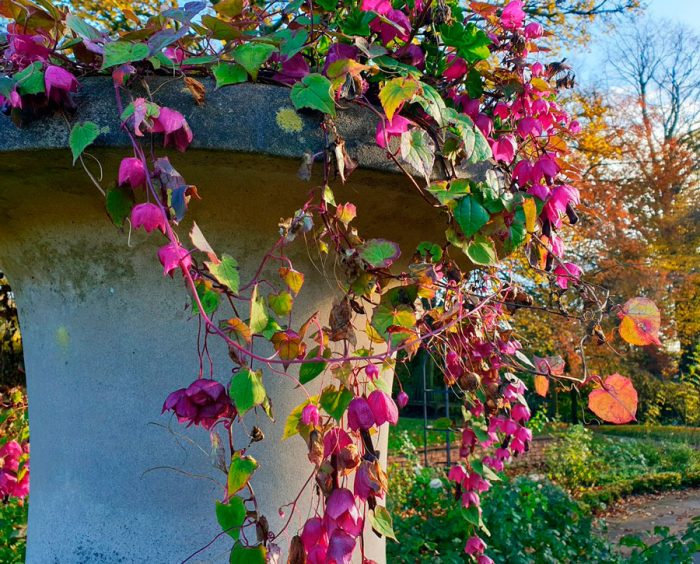Rhodochiton is a perennial vine characterized by very fast growth. Its main advantage is its spectacular inflorescences. It is widely cultivated indoors and in the garden.
Content
Description of Rhodochiton
Rhodochiton is a member of the Norichnikov family. Under natural conditions, it can be found in Mexico and Central America. Its creeping stems are able to "climb" on pre-installed special supports or on nearby trees. In length, the stems can reach about 400 cm. Heart-shaped leaves, painted in a green tint, are decorated with pale red veins. When exposed to direct sunlight, the foliage, they acquire a purple hue.
Flowers of incredible beauty, with a pleasant aroma, are formed under each leaf plate. At the same time, they are attached to the stem with a very long pedicel, which is distinguished by its flexibility. The average length of a tubular flower is about 25 millimeters. In the upper part, the flower is bell-shaped and consists of 5 petals. The color of the flowers is dark burgundy with a wine tint. There are long, thin stamens. The surface of the flower is covered with fine hair. The lighter shade of the perianth does not die off until the end of flowering. In shape, it is very similar to a five-pointed bell, which is fully open, and there are sharp points at its tops. The liana blooms throughout the summer.
This plant is cultivated both at home and in the open field. In mid-latitudes, the plant will not be able to overwinter in the garden, even if it is provided with a quality shelter. In this regard, in the garden, it is grown as an annual plant. However, if desired, the vine can be dug up, planted in a pot and placed in a greenhouse or a cool room for the winter. At the same time, in the southern regions, where the climate is mild and winters are warm, the flower can be left to winter in the open field.
To keep the Rhodochiton always looking well-groomed and effective, it is recommended to update it regularly. They do this once every five years.
Growing from seeds
When to sow Rhodochiton
The sowing time for rhodochiton seeds depends on where you are going to grow it. In the event that you plan to decorate your house with a vine, then sowing can be carried out all year round.If the seedlings are planned to be transplanted into the garden, then it is recommended to sow seeds from the last days of February to the second half of March.
Sowing rules
A seedling box is suitable for sowing seeds. It is filled with a light, loose substrate, which should include garden soil, humus and coarse sand (1: 1: 1).
Seed material needs pre-sowing preparation. To begin with it for 5-10 minutes. immersed in a pinkish solution of potassium manganese. And then the seeds are washed well with clean running water. Level the surface of the moistened soil mixture and distribute the seeds evenly over it. To make things easier for yourself, you can use a toothpick. From above, the crops are covered with a thin layer of sand or soil mixture. Then they are watered with a small amount of water, and it is most convenient to do this with a sprayer.
For sowing, you can use special cassettes, while one seed is planted in them. In this case, in the future you will not need to dive the seedlings, and this will save their root system from injury. The fact is that after a pick, young plants take root for about half a month. At this time, they grow poorly and can be very sick.
On top of the container with crops should be covered with transparent glass, you can also use a film. Keep the air temperature around 20-24 degrees. In the event that the room temperature is too low, then this can lead to a deterioration in the emergence of seedlings. Arrange for crops systematic ventilation, which is carried out every day.
Seedling care
The first sprouts should appear after 1-3 weeks. After the seedlings appear, they should be rearranged to a cooler place (from 16 to 18 degrees). This measure will be a good hardening for the seedlings, and will not allow them to stretch too much.
After the emergence of seedlings, the shelter from the container is not removed immediately. They are gradually accustomed to new growth conditions, each day gradually increasing the duration of airing. It should also be borne in mind that for seedlings, you need to choose a well-lit place, which will be sure to be protected from direct sunlight. The fact is that because of them, burns may appear on young leaves.
Seedlings should be cut open only after 3 true leaf plates are formed in it. To do this, you can use individual cassettes or small pots, reaching from 60 to 100 mm in diameter, and their height should be about 80 mm.
Plants that have been cut open most often take root after 7-15 days. Throughout this time, they look painful, while there is a stop in their growth. When the plants adapt to new conditions, they will begin to grow again. While the seedlings are sick, they should be transferred to a place that will be protected from direct sunlight. A slightly shaded area is best. Water it sparingly and only when necessary. Due to stagnant liquid in the substrate, roots can rot.
The established and matured seedlings are again transferred to a well-lit place. Next, you need to ensure that the soil mixture is moderately moist all the time. Daylight hours should be long. Therefore, for seedlings, a window sill of eastern or western orientation is chosen. If the plants do not have enough light, then they will need supplemental lighting with phytolamps, otherwise they will begin to actively stretch out.
After the root system of the plant becomes very cramped in a small container, it is transplanted into a larger pot. The main thing is to do it in time, so that there is no delay in the development of Rhodochiton.
Landing in the garden
When the seedlings grow up, they are transplanted into open ground. This is done in late spring or early summer.Before starting planting, for 1.5-2 weeks, the bushes are taught to new growth conditions, taking them out daily.
Prepare planting holes on the selected dug area and fill them with water. When the liquid is absorbed, plant the flowers by transshipment, being careful not to destroy the clod of earth. The maximum possible distance should be kept between the bushes.
Cuttings
In spring or autumn, vines can be propagated by cuttings. Cut cuttings for rooting are planted in a pot filled with a fertile substrate. Cover them with a transparent cap on top, for this you can use a cut-off plastic bottle or a plastic bag.
The sections need systematic ventilation. After they have roots, they are planted in a flower pot of suitable volume. Then, if desired, they can be planted in the garden. If the cuttings were carried out in the fall, then the planting of plants in open ground can be carried out only with the onset of spring.
Home and outdoor care
Illumination
In order for the Rhodochiton to bloom magnificently, it needs a lot of light. It can also be grown in small shade (near the fence or buildings, under the delicate shade of trees, and also in places where the bushes will be in the shade in the evening).
If the room is well lit, then for the location of the flower, you can choose a location away from the window. Also, a window sill of western or eastern orientation is perfect for him.
Soil and dressing
The soil mixture should be nutritious and loose, as well as good air and water permeability. During planting of seedlings in the ground, humus can be added to each hole. In this case, throughout the season, Rhodochiton will not need additional feeding.
During the growing season, the bushes are fed twice a month, using mineral complexes for this. It should be borne in mind that the plant needs phosphorus most of all.
Watering and moisture levels
The watering regime should be such that the substrate is always slightly damp, but the liquid does not stagnate in the roots. During a prolonged dry period, Rhodochiton needs more frequent watering.
Liana growing in room conditions requires an increased level of air humidity. To do this, it should be often moistened with a spray bottle, you can also put an open vessel with water next to the bush or use a special air humidifier.
Pruning
The plant should be systematically pruned: in the spring - before the bush blooms and in the fall - shortly before the dormant period. Shorten all stems by a third. The remaining segments can be rooted.
Do not forget that the vine needs an obligatory support!
Winter care
Rhodochiton can winter only in a room with an air temperature of 16 to 18 degrees. Watering is scarce and rare, while the duration of daylight hours should be about 14 hours.
Diseases and pests
Drying of the tops of the leaf blades of Rhodochiton can be caused by low air humidity. The bush can be affected by mildew. Sick areas are cut out and sprayed with a solution of a fungicidal agent.
Whiteflies and aphids can harm vines. They are destroyed with an insecticidal preparation. In the garden, slugs can damage foliage, they are removed from the bush by hand.
Rhodochiton in garden and interior design
To get dense thickets of Rhodochiton, you need a group planting: about a dozen bushes are planted in one place. Further, the stems can be launched along fences, walls and trees. Also, the flower is suitable for decorating gazebos and balconies.
In middle latitudes, it is recommended to grow bushes in flowerpots or tubs, which, if necessary, can be easily brought into the room. Rhodochiton also looks great in a cool winter garden, as well as on a loggia and a glazed balcony.
Having planted a flower in a pots, its stems are allowed to go around the cabinet, shelves, window frame, etc.e. You can install a special support for it.

